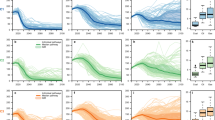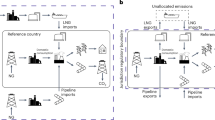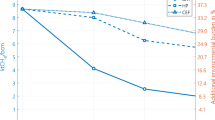Abstract
For the purpose of generating electricity, what leakage rate renders the greenhouse gas (GHG) footprint of natural gas equivalent to that of coal? This paper answers this question using a simple model, which assumes that the comprehensive GHG footprint is the sum of the carbon dioxide-equivalent emissions resulting from (1) electricity generation and (2) natural gas leakage. The emissions resulting from electricity generation are taken from published life-cycle assessments (LCAs), whereas the emissions from natural gas leakage are estimated assuming that natural gas is 80 % methane, whose global warming potential (GWP) is calculated using equations provided by the Intergovernmental Panel on Climate Change (IPCC). Results, presented on a straightforward plot of GHG footprint versus time horizon, show that natural gas leakage of 2.0 % or 4.8 % eliminates half of natural gas’s GHG footprint advantage over coal at 20- or 100-year time horizons, respectively. Leakage of 3.9 % or 9.1 % completely eliminates the GHG footprint advantage at 20- and 100-year time horizons, respectively. A two-parameter power law approximation of the IPCC’s equation for GWP is utilized and gives equivalent results. Results indicate that leakage control is essential for natural gas to deliver a smaller GHG footprint than coal.



Similar content being viewed by others
References
Allen DT, Torres VM, Thomas J, Sullivan DW, Harrison M, Hendler A, Herndon SC, Kolb CE, Fraser MP, Hill AD, Lamb BK, Miskimins J, Sawyer RF, Seinfeld JH (2013) Measurements of methane emissions at natural gas production sites in the United States. Proc Natl Acad Sci U S A 110:17768–17773
Alvarez RA, Pacala SW, Winebrake JJ, Chameides WL, Hamburg SP (2012) Greater focus needed on methane leakage from natural gas infrastructure. Proc Natl Acad Sci U S A 109:6435–6440
Brandt AR, Heath GA, Kort EA, O’Sullivan F, Petron G, Jordaan SM, Tans P, Wilcox J, Gopstein AM, Arent D, Wofsy S, Brown NJ, Bradley R, Stucky GD, Eardley D, Harriss R (2014) Methane leaks from north american natural gas systems. Science 343:733–735
Briem S, Blesl M, Fahl U, Ohl M (2004) Fossil gefeuerte kraftwerke. Lebenszyklusanalysen ausgewählter zukünftiger stromerzeugungstechniken (in German). University of Stuttgart, Institut für Energiewirtschaft und Rationelle Energieanwendung, Stuttgart, pp 255–341
Burnham A, Han J, Clark CE, Wang M, Dunn JB, Palou-Rivera I (2012) Life-cycle greenhouse Gas emissions of shale Gas, natural Gas, coal, and petroleum. Environ Sci Technol 46:619–627
Cicerone RJ, Oremland RS (1988) Biogeochemical aspects of atmospheric methane. Glob Biogeochem Cycles 2:299–327
Fearnside PM (2002) Why a 100-year time horizon should be used for global warming mitigation calculations. Mitig Adapt Strateg Glob Chang 7:19–30
Hauck M, Steinmann ZJN, Laurenzi IJ, Karuppiah R, Huijbregts MAJ (2014) How to quantify uncertainty and variability in life cycle assessment: the case of greenhouse gas emissions of gas power generation in the US. Environ Res Lett 9:074005. doi:10.1088/1748-9326/9/7/074005
Hayhoe K, Kheshgi HS, Jain AK, Wuebbles DJ (2002) Substitution of natural gas for coal: climatic effects of utility sector emissions. Clim Chang 54:107–139
Heath GA, O’Donoughue P, Arent DJ, Bazilian M (2014) Harmonization of initial estimates of shale gas life cycle greenhouse gas emissions for electric power generation. Proc Natl Acad Sci U S A 111:E3167–E3176
Howarth RW (2014) A bridge to nowhere: methane emissions and the greenhouse gas footprint of natural gas. Energy Sci Eng 2:47–60
Howarth RW, Santoro R, Ingraffea A (2011) Methane and the greenhouse-gas footprint of natural gas from shale formations. Clim Chang 106:679–690
Jaramillo P, Griffin WM, Matthews HS (2007) Comparative life-cycle air emissions of coal, domestic natural gas, LNG, and SNG for electricity generation. Environ Sci Technol 41:6290–6296
Jiang M, Griffin WM, Hendrickson C, Jaramillo P, VanBriesen J, Venkatesh A (2011) Life cycle greenhouse gas emissions of Marcellus shale gas. Environ Res Lett 6:034014. doi:10.1088/1748-9326/6/3/034014
May JR, Brennan DJ (2003) Life cycle assessment of Australian fossil energy options. Process Saf Environ 81:317–330
May JR, Brennan DJ (2004) Life cycle assessment of Australian fossil energy options (vol 81, pg 317, 2003). Process Saf Environ 82:81–81
Moore CW, Zielinska B, Petron G, Jackson RB (2014) Air impacts of increased natural Gas acquisition, processing, and use: a critical review. Environ Sci Technol 48:8349–8359
Myhre G, Shindell D, Bréon F-M, Collins W, Fuglestvedt J, Huang J, Koch D, Lamarque J-F, Lee D, Mendoza B, Nakajima T, Robock A, Stephens G, Takemura T, Zhang H (2013) Anthropogenic and natural radiative forcing. In: Stocker TF, Qin D, Plattner G-K, Tignor M, Allen SK, Boschung J, Nauels A, Xia Y, Bex V, Midgley PM (eds) Climate change 2013: the physical science basis. Contribution of working group I to the fifth assessment report of the intergovernmental panel on climate change. Cambridge University Press, Cambridge, pp 659–740, http://www.climatechange2013.org/report/full-report/ (accessed 10/20/2014)
O’Donoughue PR, Heath GA, Dolan SL, Vorum M (2014) Life cycle greenhouse Gas emissions of electricity generated from conventionally produced natural gas systematic review and harmonization. J Ind Ecol 18:125–144
Schneising O, Burrows JP, Dickerson RR, Buchwitz M, Reuter M, Bovensmann H (2014) Remote sensing of fugitive methane emissions from oil and gas production in North American tight geologic formations. Earth’s Future 2:548–558
Showstack R (2013) Shale gas development requires bipartisan path forward, U.S. Senator Wyden urges. Eos T Am Geophys Union 94:278–279
Steinmann ZJN, Hauck M, Karuppiah R, Laurenzi IJ, Huijbregts MAJ (2014) A methodology for separating uncertainty and variability in the life cycle greenhouse gas emissions of coal-fueled power generation in the USA. Int J Life Cycle Assess 19:1146–1155
Tollefson J (2013) Methane leaks erode green credentials of natural gas. Nature 493:12–12
Turconi R, Boldrin A, Astrup T (2013) Life cycle assessment (LCA) of electricity generation technologies: overview, comparability and limitations. Renew Sust Energ Rev 28:555–565
U.S. Energy Information Administration (2014) How much coal, natural gas, or petroleum is used to generate a kilowatthour of electricity? U.S. Energy Information Administration, Washington, http://www.eia.gov/tools/faqs/faq.cfm?id=667&t=2 (accessed 11/20/2014)
Victor DG (1992) Leaking methane from natural-gas vehicles - implications for transportation policy in the greenhouse Era. Clim Chang 20:113–141
Voorspools KR, Brouwers EA, D’haeseleer WD (2000) Energy content and indirect greenhouse gas emissions embedded in ‘emission-free’ power plants: results for the low countries. Appl Energy 67:307–330
Wigley TML (2011) Coal to gas: the influence of methane leakage. Clim Chang 108:601–608
Zhang XC, Myhrvold NP, Caldeira K (2014) Key factors for assessing climate benefits of natural gas versus coal electricity generation. Environ Res Lett 9:114022. doi:10.1088/1748-9326/9/11/114022
Acknowledgments
The authors thank Indrani Pal for reviewing a preliminary draft of this paper, and three anonymous referees whose feedback helped to improve the clarity and rigor of the presentation.
Contributions
NS developed the model, derived the equations, and created Figs. 2 and 3. DCM updated these results using the most recent IPCC report, created Fig. 1, and drafted the paper.
Author information
Authors and Affiliations
Corresponding author
Rights and permissions
About this article
Cite this article
Sanchez, N., Mays, D.C. Effect of methane leakage on the greenhouse gas footprint of electricity generation. Climatic Change 133, 169–178 (2015). https://doi.org/10.1007/s10584-015-1471-6
Received:
Accepted:
Published:
Issue Date:
DOI: https://doi.org/10.1007/s10584-015-1471-6




